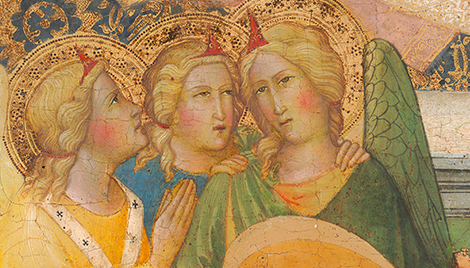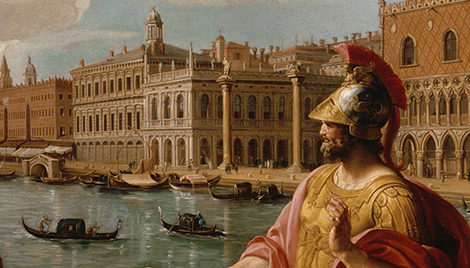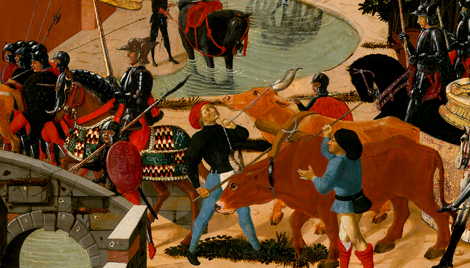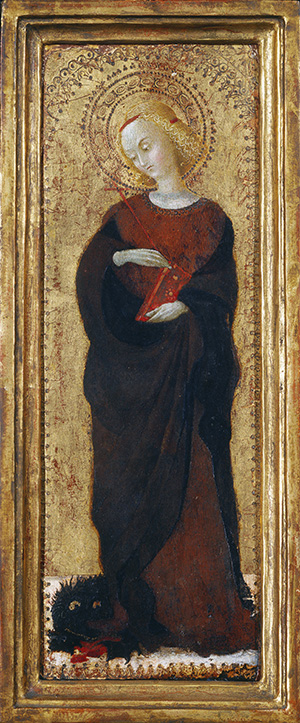Saint Margaret
Saint Margaret
- Artist
- Sassetta
- Artist Dates
- probably 1392-1450
- Artist Nationality
- Italian
- Title
- Saint Margaret
- Date
- c. 1435
- Medium
- tempera on poplar panel
- Dimensions
- 28.5 x 10.6 cm (11 1/4 x 4 3/16 in)
- K Number
- K1285B
- Repository
- National Gallery of Art
- Accession Number
- 1943.4.4
- Notes
Provenance
Possibly in a German private collection in the nineteenth century. [1] (Robert Langton Douglas [1864-1951], London), in the early 1900s; [2] sold to Dan Fellows Platt [1873-1938], Englewood, New Jersey in March 1913; [3] sold March 1939 by the Trustees of the Platt Estate to the Samuel H. Kress Foundation, New York; [4] gift 1943 to NGA. [1] NGA 1943.4.4 and .5 were originally the wings of a small portable triptych. The central panel, first thought to be another NGA painting by the same artist, _Madonna and Child_ (1939.1.246), was later recognized as the _Virgin and Child Crowned by Angels_ in the Gemäldegalerie, Berlin, at the top of which appear the dove of the Holy Spirit and the bust of God the Father in blessing. According to the 1986 catalogue of the Berlin collection (_Gemäldegalerie Berlin. Gesamtverzeichnis der Gemälde_, Berlin, 1986: 68), this painting presumably comes from the Solly collection, which was purchased for the Berlin gallery in 1821. However, since the panel is listed for the first time in the 1891 edition of the gallery's catalogue (_Königliche Museen zu Berlin. Berchreibendes Verzeichnis der Gemälde_, Berlin, 1891: 256) with a notation saying it was transferred into the gallery from the storerooms in 1885, possibly it was a relatively recent purchase. Like the Berlin panel, the wings of the triptych (the NGA paintings) must also have been surmounted by gables, and these parts were very likely painted, according to custom, with the figures of the angel Gabriel and the Virgin Annunciate. Fragments corresponding to this description and almost certainly identifiable as the missing pieces of the NGA panels are now in the Frick Art Museum in Pittsburgh. These panels are cited in the Frick Collection for the first time by John Pope-Hennessy, _Sassetta_, London, 1939: 114, 136, who also reports their alleged provenance from a French private collection. He points out, however, that these are probably the same paintings cited by Raimond van Marle, _The Development of the Italian Schools of Painting_, 19 vols., The Hague, 1923-1938: 9(1927):324, among Sassetta's works as "fragments of a triptych depicting the angel and the Virgin of the Annunciation in a private collection in Germany." Miklós Boskovits, author of the NGA systematic catalogue entry on the two NGA paintings, thus suspects that these and the two Frick fragments at about mid-nineteenth century (or in any case some time before 1885), were still together with the Virgin now in Berlin, in a private German collection. [2] See Pope-Hennessy 1939: 91 n. 32, and Denys Sutton, "Robert Langton Douglas. Part 3," _Apollo_ 109, no. 208 (June 1979): 463, 469. [3] Acquisition date according to Dan Fellows Platt Papers, Department of Rare Books and Special Collections, Princeton University, NJ; box 2, folder 23, call number C0860. F. Mason Perkins, "Alcuni dipinti senesi sconoscuti o inediti," _Rassegna d'Arte_ 13, no. 8 (December 1913): 195, reports that NGA 1943.4.4 and 1943.4.5 were acquired "recently" by Dan Fellows Platt; in an earlier essay on this ("Dipinti italiani nella raccolta Platt," _Rassegna d'Arte_ 11 [January 1911]: Part I, 1-6, and [September 1911]: Part 2, 145-146), he does not yet seem to know these paintings. [4] Fern Rusk Shapley, _Catalogue of the Italian Paintings_, 2 vols., Washington, D.C., 1979: 1:416.






